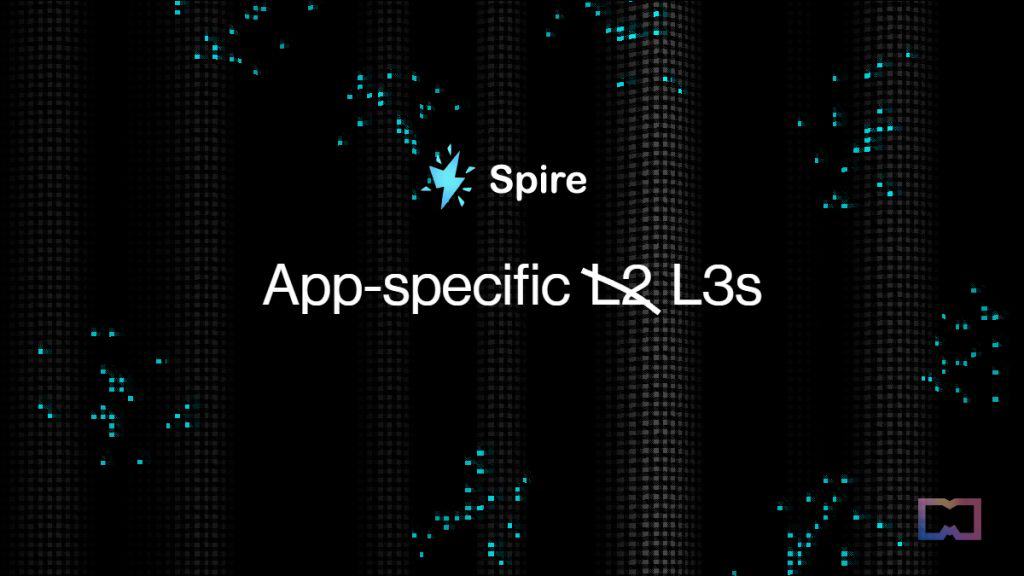Spire Labs Introduces its Modular Layer-3 Protocol Built on Top of zkEVM Layer-2s


In Brief
Spire Labs, the developers of app-specific Layer-3 networks on zkEVMs, has introduced its eponymous L3 protocol.
The Spire protocol is a type of Rollup-as-a-service(RaaS), and also an L3-as-a-service.
The Spire architecture allows app-specific L3s to tap into smart contracts on L2s.
Spire Labs, the developers of app-specific Layer-3 networks on zkEVMs, has introduced its eponymous L3 protocol to support fractal scaling on Ethereum.

The idea of fractal scaling was first advocated by StarkWare in 2021, as the company envisioned a future where multiple L3s would operate on top of L2s, and even more layers (L4) could be created on L3 to achieve fractal layering solutions.
The Spire protocol functions as a Rollup-as-a-service (RaaS) and an L3-as-a-service, offering a platform for developers to easily create their own appchain L3s that are interoperable.

What sets Spire apart from other RaaS is its focus on L3 built on top of zkEVMs. Through its recursive zk rollup architecture, L3s spun up with Spire can scale vertically and can tap into contracts on L2s such as Scroll. In future, Spire will introduce its own L3 that empowers other appchains created using the protocol.
“We foresee that more onchain activity will shift to L2s in the future, and Spire L3s can leverage smart contracts, liquidity, and protocols on L2s, maximizing the power of composability,” Spire Labs tweeted.
Besides building on top of zkEVM, Spire is also leveraging RISC Zero for its execution environment, enabling developers to write contracts in Rust, Go, and C++. On Wednesday, RISC Zero announced the close of its $40 million Series A round led by Blockchain Capital.
“With this execution environment, more developers, including non-crypto developers today, will hack more casually and easily on a decentralized tech stack. We will see more innovation in a world where 10,000 apps are built in a week compared to a world where only 10 apps are built in a week,”
Spire wrote in a blog post.
Spire’s path towards L3
The Spire architecture allows app-specific L3s to tap into L2 smart contracts. For instance, web3 gamers can exchange their in-game currency for ETH by using the Uniswap liquidity available on L2s like Scroll. This means that L3s can take advantage of the resources on L2 platforms and benefit from the network effects of the EVM (Ethereum Virtual Machine).
As Spire noted, the benefits of L3s include:
- Hyper scalability
- Greater control by app developers
- Functioning as a test network for L2s (similar to Kusama for Polkadot)
- Privacy
In Spire’s perspective, app developers having greater control is an underrated advantage. App developers using Spire can create appchains that offer the first few transactions to users for free.
They will have also the opportunity to generate revenue based on the transaction fees and MEV (Miner Extractable Value), even without issuing tokens. Alternatively, if app developers do issue tokens, those tokens can capture value based on the transaction fees. App developers can also configure appchains to allocate transaction fees to a referrer user.
Spire is currently in the process of exploring fee and MEV distribution mechanisms in collaboration with the Espresso team, with an aim to achieve cross-rollup communications and decentralization of Spire chains.
Disclaimer
In line with the Trust Project guidelines, please note that the information provided on this page is not intended to be and should not be interpreted as legal, tax, investment, financial, or any other form of advice. It is important to only invest what you can afford to lose and to seek independent financial advice if you have any doubts. For further information, we suggest referring to the terms and conditions as well as the help and support pages provided by the issuer or advertiser. MetaversePost is committed to accurate, unbiased reporting, but market conditions are subject to change without notice.
About The Author
Cindy is a journalist at Metaverse Post, covering topics related to web3, NFT, metaverse and AI, with a focus on interviews with Web3 industry players. She has spoken to over 30 C-level execs and counting, bringing their valuable insights to readers. Originally from Singapore, Cindy is now based in Tbilisi, Georgia. She holds a Bachelor's degree in Communications & Media Studies from the University of South Australia and has a decade of experience in journalism and writing. Get in touch with her via [email protected] with press pitches, announcements and interview opportunities.
More articles

Cindy is a journalist at Metaverse Post, covering topics related to web3, NFT, metaverse and AI, with a focus on interviews with Web3 industry players. She has spoken to over 30 C-level execs and counting, bringing their valuable insights to readers. Originally from Singapore, Cindy is now based in Tbilisi, Georgia. She holds a Bachelor's degree in Communications & Media Studies from the University of South Australia and has a decade of experience in journalism and writing. Get in touch with her via [email protected] with press pitches, announcements and interview opportunities.

















































